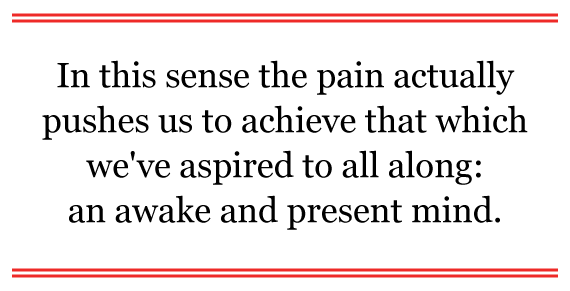Pain, by definition, kind of sucks. So unpleasant emotions like fear and anger often arise along with it, making for an especially demoralizing experience.
We usually try, then, to simply get rid of it. Being cured of pain is the outcome our culture teaches us to expect—we carry a sense of entitlement that life should be free from pain. But one of the worst parts of the pain syndrome—whether the discomfort is short-term, as in meditation, or long-term, with chronic pain—is that our physical pain and our urge to nullify it feed off one another in a most unfortunate loop, and our life comes to revolve around our discomfort.
It is essential to understand that both our pain and the suffering that arises from it are truly our path, our teacher, in that we can learn from them and experience our life more deeply as a result. Once we understand that pain is our path, we can begin to work with our pain and our suffering in a more conscious way. At the very least, we can consider our pain an opportunity to learn from our many attachments—especially our attachments to comfort, to body image, to control, and in the case of chronic pain, to our seemingly never-ending misery.
Related: 12 Things You Should Never Say to Sick People
Yet practicing with our pain gradually frees us from these attachments. When pain arises, instead of immediately thinking, “How can I get rid of this?” we can say “Hello” to it, and ask, “What can I learn from this?” It’s not always easy to do this, but when possible, it turns the whole experience upside down.
Once we do remember to ask what we can learn, it’s essential that we notice the difference between pain itself and how we relate to it. Often we conflate the two as one confused whole. Pain is the physical experience of discomfort; how we relate to it, meanwhile, is mental and emotional. For example, in meditation, when we relate to knee or back pain with fear or self-pity, it exacerbates the uncomfortable physical sensation. If we relate to pain with an element of curiosity, however, the experience becomes much more tolerable.
That said, there may be times when nothing provides relief. In such cases, it’s healthy to intentionally distract ourselves from our bodies and minds. This might include activities we genuinely enjoy—like walking in nature or listening to music—since it’s so easy, when in pain, to forget about the things that bring us happiness. By diverting our attention in this way, we bring lovingkindness to ourselves and our situation.
Related: Pain Without Suffering
Even though practicing with physical pain and its related emotional dis-ease can prove difficult, it’s most often worthwhile.
First off, in working with the emotions that we associate with physical pain, we need to recognize our judgments—especially insofar as we normally accept them, unquestioned, as the truth. This recognition allows us to see how our blind belief in thought solidifies our unpleasant physical experience of pain. One particularly pernicious tendency is catastrophizing, automatically anticipating the worst. If we get a pain in the belly that lasts for a few days, we may start believing we have cancer. To counter such thinking, we can deploy a simple phrase to remind ourselves that these imagined ailments are “not happening now.” Another pernicious tendency is selective filtering, whereby we ignore positive experiences and magnify negative ones. In the case of that same belly ache, we may focus all of our attention on how our pain bothers us, rather than how our eyes, ears, legs, and all the rest work fine.
Precisely recognizing our pain-related beliefs is the first step toward loosening their grip on us. Once we recognize these patterns we can begin to objectify them, labeling them or even writing them down. Labeling thoughts like, “I can’t take this,” “What’s going to happen to me?” or “Why me?” allows us to step outside of them. In the absence of labeling we may come to see ourselves as victims of our pain. With the objective awareness that comes with labeling, however, such thoughts eventually appear as just thoughts—nothing more. We begin to realize that they may not even be true.
In addition to working with the beliefs and reactions that arise from our pain, we need to learn how to work with the experience of pain itself. One effective way of doing so is to focus directly on the specific pain sensations. We bring awareness to wherever we experience tightness or pushing away, thereby softening into these painful areas. Then we gradually feel the texture of the pain—the aching, the stabbing, the burning, or whatever painful quality might be present. When we do this with the curiosity of a scientist, it paradoxically allows us to experience the pain, at least some of the time, as no more than a strong sensation.

As we allow ourselves to stay with the pain, we may notice that it doesn’t remain the same. Indeed, the sensations often change rapidly and sometimes even disappear altogether. This realization takes us out of the catastrophic mindset that imagines our pain will always be horrible or unbearable.
While staying with uncomfortable sensations is one way of working with pain, another effective way is to bring attention to the breath. Normally when we’re in pain, the unpleasant sensations fill up our entire awareness. But when we include the breath, some of our attention rests on the rhythm of our inhalation and exhalation, which places the pain in a larger container of awareness.
We can even use the breath to help heal the pain, breathing the physical sensations in and out as though giving a gentle massage. This is especially helpful with long-term or chronic pain, like the periods of nausea I’ve dealt with for over 20 years as a symptom of an immune system disorder. When the nausea gets intense, I curl up into fetal position in bed, breathing into the center of the chest on the in-breath and extending lovingkindness to my immune system via the out-breath. I don’t intend to make the nausea go away, but to relate to it in a more friendly way. When I subsequently perceive the nausea not as pain but as physical energy, I’m struck by a sense of quiet joy, in which it becomes clear that I am more than just this body.
Focusing on the breath in order to bring about a more open awareness is a very popular practice; but, the truth is, such expansive attention to our myriad sensory and environmental stimuli is a rare occurrence. It results from conscious cultivation, with a continuous, soft effort to grow attention beyond our physical symptoms of pain. In this sense the pain actually pushes us to achieve that which we’ve aspired to all along: an awake and present mind.
When practicing with our pain, we also develop compassion for others who may be suffering from similar discomfort. One thing I do during bouts of strong physical pain is picture people I know who are also in pain, and then imagine the countless others who are in pain in that very moment. On the in-breath I breathe the images of those in pain into the center of the chest and on the out-breath I extend the wish for healing to myself and others. In this way, our personal pain connects us with the pain of others, the pain of the world. This can deepen our sense of compassion, and the wish that the suffering of others be healed. It will also diminish the sense of isolation we often feel when in pain.
Inevitably, there will be times when we feel overwhelmed while dealing with physical discomfort—when the experience of powerlessness wraps itself tightly around our small sense of self. One practice that many have found helpful when feeling overwhelmed is to bring awareness to the center of the chest, breathing as if you were breathing the dark feelings directly into the chest center. With each breath you breathe the feelings in a little deeper. Then with a long, slow exhale you just exhale, not trying to change or let go of anything, but rather simply feeling what’s there. What actually happens during this process of breathing into the chest center is a mystery, but you can see for yourself how this practice allows us to gracefully endure what would otherwise feel unbearable. In surrendering to our deepest fears, we put ourselves in touch with the fundamental awareness of just being—the true ground that is always available to us.
Even if we don’t have intense pain, it is well worth working with small aches so we don’t get blindsided by more severe pains down the road. In any case, let’s try to remember that while we may never prefer to have pain, it can nevertheless push us in ways we would not otherwise push ourselves—into a deeper and ultimately more appreciative experience of what it is to be genuinely alive.
[This story was first published in 2015]
Thank you for subscribing to Tricycle! As a nonprofit, we depend on readers like you to keep Buddhist teachings and practices widely available.
